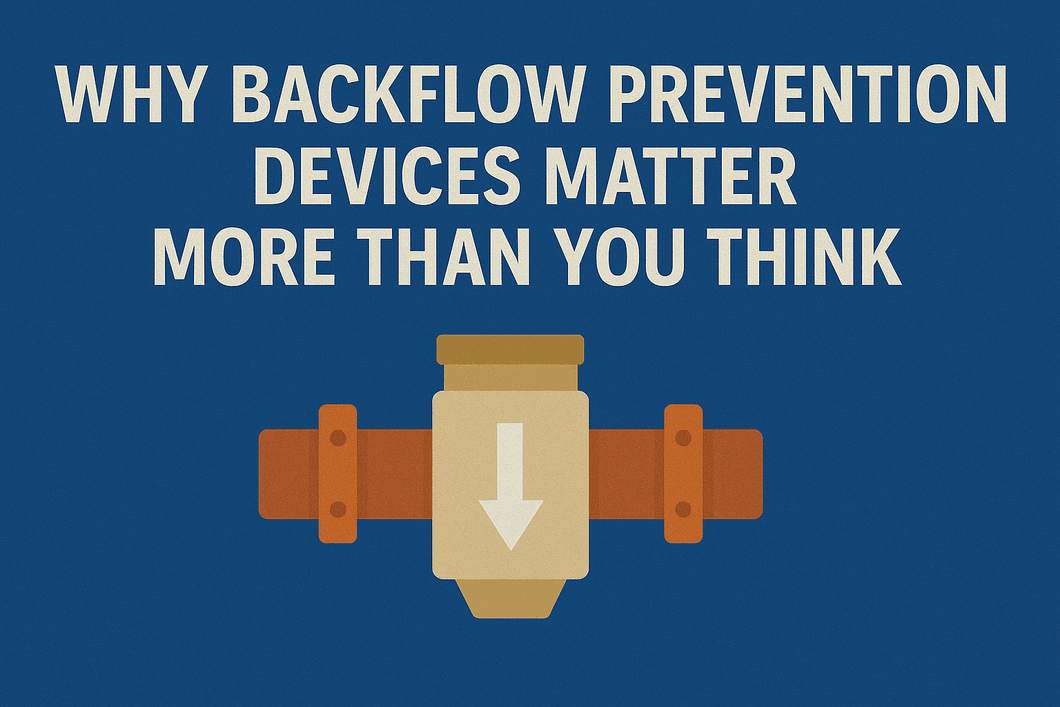Understanding Backflow: A Hidden Risk in Plumbing Systems
Backflow is the unwanted reversal of water flow in a plumbing system, where contaminated water can flow backward into the clean water supply. This can happen due to a sudden drop in water pressure (backsiphonage) or an increase in downstream pressure (backpressure). For commercial property owners and municipalities, this isn’t just an inconvenience—it’s a serious public health hazard.
Contaminants such as chemicals, pesticides, human waste, industrial byproducts, or bacteria can infiltrate the drinking water, leading to health outbreaks, legal liability, and costly cleanups. The solution? Backflow prevention devices.
What Is a Backflow Prevention Device and How Does It Work?
A backflow prevention device is a mechanical valve system that ensures water flows only in one direction—into the building and never back into the public water supply. These devices are installed at cross-connection points where potable water systems are vulnerable to contamination.
There are several types of backflow preventers:
- Air Gap: A physical space between the water outlet and the flood level.
- Double Check Valve Assembly (DCVA): Two independent check valves in series.
- Reduced Pressure Zone (RPZ): Offers the highest level of protection with a relief valve.
- Pressure Vacuum Breaker (PVB): Typically used for irrigation systems.
Each type serves specific scenarios depending on hazard level, system pressure, and industry requirements.
Why Commercial Properties and Municipalities Are Especially at Risk
1. Complex Plumbing Networks
Commercial facilities, like factories, hospitals, hotels, and multi-unit buildings, often have extensive plumbing systems with multiple cross-connections. Without proper backflow prevention, a single point of failure could allow contaminants to affect the entire building or even spread to city water supplies.
2. Use of Hazardous Substances
Many commercial properties use chemicals in operations such as cleaning, manufacturing, or landscaping. If backflow occurs, these substances can seep into potable water, causing irreversible damage and health issues.
3. High Water Usage
Municipal buildings and industrial complexes consume significantly higher volumes of water, creating higher pressure fluctuations. This increases the likelihood of backsiphonage or backpressure, making backflow preventers a non-negotiable safety requirement.
The Real Cost of Ignoring Backflow Protection
Health Risks and Outbreaks
Backflow incidents have been linked to outbreaks of E. coli, Legionnaires’ disease, and chemical poisoning. Municipal water contamination can quickly escalate into a public health emergency, affecting thousands of people.
Legal Liability and Fines
Regulatory bodies such as the EPA, local building codes, and state health departments require backflow prevention in many commercial scenarios. Failing to comply can lead to:
- Fines and penalties
- Lawsuits
- Insurance claims
- Business interruptions
Reputation Damage
A single contamination event can ruin a company’s or municipality’s public trust. News of tainted water spreads fast, especially in today’s digital age, damaging the brand for years.
Benefits of Installing Backflow Prevention Devices
1. Guaranteed Water Purity
Installing a certified backflow device ensures clean, safe water, protecting both occupants and the community.
2. Compliance with Local Regulations
Meeting backflow requirements helps avoid fines, ensures smooth permit approvals, and keeps your property compliant with health and safety standards.
3. Risk Mitigation
Backflow devices are a proactive approach to risk management. They minimize the threat of emergency cleanups, lawsuits, and business downtime.
4. Protects Infrastructure
Municipal water systems cost billions to build and maintain. Backflow prevention helps safeguard this critical infrastructure, reducing the burden on public services.
Who Needs Backflow Preventers the Most?
Municipalities
- Parks & Recreation (with irrigation systems)
- Water treatment plants
- Public pools and fountains
- Fire hydrant systems
Commercial Buildings
- Hotels and resorts
- Hospitals and clinics
- Manufacturing plants
- Car washes and service stations
- Multi-family housing complexes
Agricultural and Landscaping Services
- Greenhouses
- Golf courses
- Nurseries
- Farms using fertilizers and pesticides
Signs That Your Property May Be at Risk
- Old or outdated plumbing systems
- Changes in water pressure
- Previous contamination incidents
- Lack of regular inspections
- Irrigation or fire sprinkler systems present
If any of these apply, your risk of backflow contamination is high, and you should consult a licensed plumbing professional immediately.
Backflow Testing and Maintenance: A Critical Responsibility
Backflow devices require annual inspection and testing by a certified technician. This ensures:
- Proper function and sealing of valves
- Identification of wear or corrosion
- Updates based on code changes
Neglecting these checks can invalidate warranties and put your system out of compliance.
Choosing the Right Backflow Prevention Device
When selecting a device, factors include:
- Type of hazard: Low or high risk
- System pressure
- Location of installation
- Local code requirements
It’s essential to work with qualified professionals who can conduct a hazard assessment and install the appropriate protection.
Partnering with a Reliable Plumbing Contractor
For businesses and municipalities, it’s vital to choose a licensed contractor experienced in:
- Commercial-grade plumbing systems
- Municipal compliance codes
- Testing and certification protocols
This ensures your investment not only protects but also performs long-term with minimal issues.
Future-Proofing Your Property and Community
In a world where public health, safety, and compliance are under constant scrutiny, investing in backflow prevention devices is more than just ticking a box—it’s a responsibility.
By protecting your water supply, you’re not only safeguarding your property but also contributing to a safer, healthier, and more resilient community.
Conclusion: Prevention Is Always Better Than Cure
Backflow prevention devices might seem like a minor fixture, but they play a critical role in safeguarding lives, infrastructure, and reputations. For commercial property owners and municipalities, these devices are not optional—they are essential.
By prioritizing regular maintenance, choosing the right system, and staying compliant with regulations, you can prevent costly disasters, ensure safe drinking water, and maintain peace of mind.


